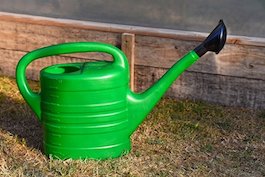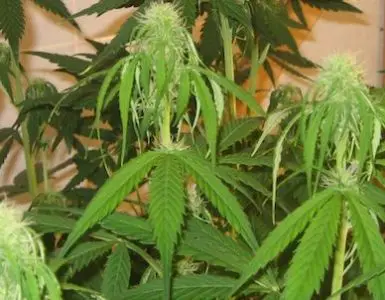Disclosure: As an Amazon Associate I earn from qualifying purchases. more info
So you have been growing your own marijuana at home, and things have been going quite well, until now. Oh no, you have spotted what appears to be mold on your weed plants. Yeah, it’s a big deal, something that needs to be taken care of ASAP.
Today we want to talk about how to get rid of mold on cannabis plants. Something you need to know is that mold multiplies fast and it can have disastrous effects on your cannabis crop.
Using fungal sprays or getting rid of infected leaves, even full infected plants, are about the only options you have at your disposal.
Therefore, one of the best things you can do is to prevent mold from growing on your weed plants in the first place.
Contents
2 Common Types of Mold that Affect Cannabis Plants
The first piece of info you need to know is that there are a couple common types of mold that can grow on your weed plants.
In order to quickly and effectively deal with moldy weed plants, you first need to be able to identify if it is mold and what kind of mold it is.
1. White Powdery Mildew
The first and most common type of mold that you may find on your weed plants is powdery white mildew. This will look like a thin layer of white mold, like a thin layer of fuzzy white, kind of like a small and fluffy white blanket.
Now, this can actually be somewhat hard to detect, especially in the early stages, as small powder mildew mold infections can be nearly invisible to the naked eye.
Often, by the time you will be able to see it plainly just by looking at the weed plant, the mold infestation will already be quite severe. However, if you look closely, even in the early stages, you might be able to see small white bumps on affected leaves.
This type of mold produces black spores, lots of them, which fly through the air and quickly infect everything in the vicinity.
Therefore, identifying and treating white powder mildew mold as soon as possible is essential to the survival of your weed plants.
The reason for this is because that layer of mold will prevent the cannabis plant from being able to engage in photosynthesis.
In other words, your cannabis plant will literally suffocate and stop creating its own food source and will thus eventually die.
2. Bud Rot AKA Botrytis
The other type of mold which commonly grows on weed plants is known as bud rot, also known as botrytis.
Botrytis often appears at the base of the stem of the marijuana plant, which can make it very hard to detect, especially in the early stages.
Generally speaking, the first signs of a bud rot infection will be when the kolas and small leaves of the weed plant begin to get discolored, dried out, and wither away.
In the later stages, botrytis will also contain little black specs, which are the spores created by the mold, which can then float through the air and infect everything in a fairly large vicinity.
If you look closely, you may also notice a fluffy substance growing on the buds themselves.
The color of this fluffy stuff will usually be anywhere from white to grey, or even a blueish green.
If your weed plants have botrytis, you are in trouble because it quickly spreads to other plants and will cause all infected plants to die in a matter of weeks.
On a side note, these mold spores are also quite toxic and super unhealthy to inhale.
Why Does Mold Occur on Marijuana Plants? PREVENTION IS KEY!
Alright, so as you will find out later on, treating moldy weed plants is not easy and it’s often not effective either. However, the best way to go bout this is to prevent mold from occurring in the first place.
As we have and will stress again, the best way to not have to deal with this issue is to prevent mold from occurring the first place.
However, you therefore need to know exactly what causes the mold to appear in the first place.
Something we do want to note is that mold usually requires at least two of the following factors or conditions to really grow and spread, and these conditions usually need to last for at least a few days.
However, if all three of the following conditions persist for days on end, the chances of mold growing and spreading are quite high.
1. Cool Air
One thing which allows mold spores to take hold, multiply, and flourish is cool air. Generally speaking, mold will grow in temperatures under 20 degrees Celsius.
Now, this should usually not be a problem indoors, because your grow room should be well over 20 degrees for proper marijuana growth.
However, of course, your grow room may be cooler for one reason or another, but you need to do everything you can to keep it well over that 20 degree mark.
All of that said, cool temperatures are usually an issue when growing cannabis outdoors, especially during the night in the fall and spring.
This is kind of left up to chance, because if outside temperatures drop below that 20 degree mark, and they stay that way for a few days, well, there’s nothing you can do to control the weather.
However, indoors the solution to prevent mold is quite easy in this respect. Just make sure to have a good heater that can maintain the proper air temperature.
2. Stagnant Air
Something else that really helps mold take hold and grow fast is stagnant air. This is because stagnant air, which means that there is little or no airflow, all stays in the same place.
If there is no airflow, especially with old air being evacuated from the area, mold spores will stay in one place and be allowed to multiply.
Now, this tends not to be a huge problem with outdoor weed growing, as there tends to be some wind or at least an occasional breeze outside, but it can still sometimes happen of course.
However, this can be and often is a big problem when growing weed indoors.
Often, people growing weed on a budget in a small room or a grow tent will neglect to get some good fans and ventilation systems.
Therefore, the solution to prevent stagnant air and maintain good airflow is to get yourself a good weed grow room or grow tent ventilation system, complete with ducting and an air extractor.
A couple of small air fans to create airflow will help as well.
3. Excessive Moisture
Perhaps the single biggest thing which causes mold to grow on weed plants is excessive moisture. Mold requires a lot of humidity to really grow and spread.
So, if it is perpetually raining outdoors, you constantly overwater the soil, or the overall humidity in your grow room is far to high, it can indeed cause mold to grow and spread.
If we are talking about outdoors, you may want to get some posts and tarps to cover up the plants before it rains, although if you just live in a very humid environment, when growing outdoors, there’s not much you will be able to do.
However, when growing weed indoors, you can prevent mold from occurring due to excessive humidity by keeping the grow room or grow tent properly ventilated, by maintain the right temperature, and a good old dehumidifier works wonders too.
Getting Rid of Mold on Cannabis Plants
As discussed in great detail, prevention is the best treatment hands down. However, if you do find yourself dealing with moldy weed plants, quite honestly, you are in some trouble.
No, of course there are some treatments and solutions, although they are limited in number and effectiveness.
The big problem with mold is that once your plants have it, even if you manage to get rid of some of it, or even treat a whole plant, mold spores are quite resilient and numerous.
Permanently getting rid of mold is exceedingly difficult. If one plant has it, chances are that it has already spread to the others in the vicinity.
Cut & Run
Quite honestly, the best treatment for moldy weed plants is to cut and run.
Mold is so hard to get rid of, that even if you manage to contain it or treat a part of a plant for the time being, chances are that you will never really get rid of it.
Sooner or later, the chances are that the mold will spread to all of the plants and kill them all.
Therefore, the best solution, if you notice that your weed plants are moldy, is to cut off the sections with mold ASAP and throw them out.
For botrytis and white mildew alike, if the infestation is severe, it’s best to get rid of the whole plant to prevent the healthy ones from suffering the same fate.
You will also want to move the healthy plants to anew space for the time being, one that has not yet been infected with mold spores.
For Botrytis
When it comes to botrytis, this is literally impossible to get rid of completely. Now, you can use a fungal spray that can help control the spread of the bud rot.
However, even the best sprays will usually only contain the spread of but rot, not eliminate it.
However, certain botrytis sprays can allow your weed plants to last until harvest.
However, this is quite a gamble, because botrytis, if not properly contained, will spread quickly, and yes, it is very harmful to weed plants and even to humans as well.
For White Mildew
White powdery mildew is a little easier to deal with. Here, you can mix two teaspoons of cider vinegar with a liter of water, or make a mixture of 60% milk and 40% water. Put either mixture into a spray bottle and generously coat your plants.
Make sure to not only spray your weed plants where you can see mold. As we discussed before, mold is often hard to see, so it’s best to spray the whole plants.
Both will work to kill powdery mildew, but if the caser is severe, it may not remove it all, and it may not remove enough to really control the growth and spread of it.
For powdery mildew, you can also use a fungicide, a special spray used to kill mold. However, if the case is severe, even these may not kill all the mold.
Moreover, it’s also hard to kill the mold spores floating in the air. You have to get rid of all mold and spores for this to be effective.
All of that said, do keep in mind that fungal sprays will absorb into the weed, and it will negatively affect the smell and taste of the weed.
Fungal sprays will often cause the weed to be of a lower quality. Moreover, smoking weed coated in mold or fungal sprays is not very healthy.
Conclusion
When all has been said and done, although there are some sprays that be used as mold treatments on cannabis plants, the usually are not 100% effective. Yes, prevention is the best thing you can do here.
Simply put, the best solution when you find mold on your weed plants is to immediately separate the healthy plants from the sick ones, and immediately get rid of the affected plants.
It’s best to get rid of the sick weed plants and have a good chance of keeping the healthy ones from developing mold.





